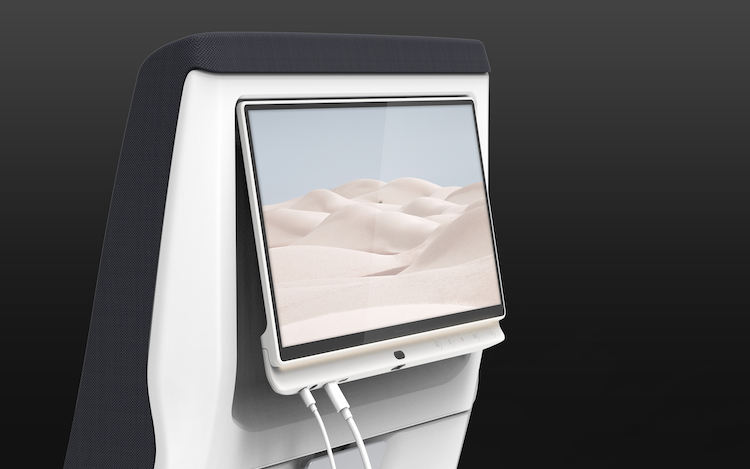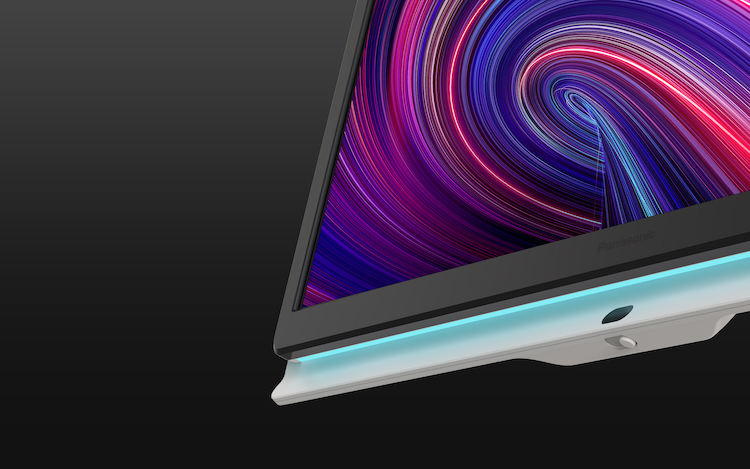Up close and personalized: Panasonic Avionics's fresh approach
This is a special feature from PAX Tech's 2022 October APEX EXPO issue on page 8.

New approach: Astrova, by Panasonic Avionics seat-back IFE system in Economy Class
Panasonic Avionics unveiled what it dubs “the future of airline passenger engagement” with the launch of its new IFE seat-end system: Astrova.
Introduced at AIX in Hamburg this year, Astrova seeks to demonstrate the company’s new approach to the market and its mindset in developing products and services to help airlines drive higher net promoter scores (NPS), enhance passenger engagement, boost revenue and deliver operational efficiencies through IFE. It uses the latest consumer innovations to deliver unique passenger experiences that help carriers achieve their business goals, the company tells PAX Tech.
Astrova was created to redefine the role of seatback IFE and reinforces its position as a prime opportunity for airlines to engage with passengers. Because the average flight is five hours, in-seat IFE offers a much longer dwell time than airline apps and other marketing channels. Astrova has been designed to provide “significantly” more opportunities to immerse passengers in an airline’s brand experience for both single-aisle and twin-aisle aircraft, according to Panasonic Avionics.
The solution is described as a seamless blend of newly developed hardware, software and enterprise solutions that aim to revolutionize the inflight entertainment experience. It lets airlines quickly and easily optimize the seatback experience to their individual commercial objectives, transforming the in-seat system into a highly valuable, flexible and easily configured passenger experience that caters to the personal and business needs of travelers each time they board an aircraft.
Cinema-grade 4K OLED screens
Onboard Astrova-equipped aircraft, every passenger immerses themselves in cinema-grade 4K OLED screens with high dynamic range (HDR). Passengers also enjoy high fidelity audio through traditional wired connections or via Panasonic Avionics’ Bluetooth technology. By seamlessly interfacing their personal devices to the IFE system, passengers can create a multi-screen, multi-purpose environment which they are accustomed to at home.

OLED technology with high dynamic range will be part of the Astrova package
As an industry first, Astrova will provide a dedicated 67W of USB-C power to fast-charge passenger devices including notebooks and laptops.
Panasonic Avionics’ newest IFE seat-end solution also features programmable LED lighting that enhances passenger experience and enables airlines to optimize the cabin environment. Airlines can easily change the lighting to complement various phases of flight like the food and beverage service. They also have the option to let passengers customize the lighting experience to their own personal preferences.
Designed with modularity, scalability and flexibility as a priority, Astrova seeks to address the needs of modern airlines operating in a fast-changing market. Key hardware and software components can evolve over time to meet changing market requirements and satisfy ever-increasing passenger expectations. For example, a removable peripheral bar gives airlines the ability to easily add, upgrade or remove features such as USB power, Bluetooth audio and other options. It is also designed to be backward-compatible with other Panasonic Avionics’ systems such as eX1, eX3 and NEXT, enabling operational commonality in areas such as media loading, spares and repairs for some line replaceable units, and cabin crew operations.
To help airlines meet their sustainability goals, Astrova offers significant weight savings compared to other seat-end architectures, which will help airlines reduce fuel burn to help meet the airline industry’s climate goals.
To demonstrate Astrova’s industrial design, ease of installation and an improved passenger experience, Panasonic Avionics partnered with Recaro Aircraft Seating, combining Astrova with Recaro’s CL3810 Economy Class seat.
The seamless integration of the Astrova seat-end solution into the CL3810 optimizes the passenger journey for single-aisle and twin-aisle aircraft. While experiencing the comforts of the CL3810 seat, travelers can simultaneously enjoy entertainment amenities such as a 4K OLED screen with high dynamic range (HDR) and Panasonic’s award-winning Bluetooth technology, as well as 67W of USB-C power to fast-charge smart devices.
Several major airlines have selected Astrova, and Qatar Airways was recognized during AIX 2022 as the first airline to choose Astrova for its fleet.
Driving airline loyalty
Also in Hamburg, Panasonic Avionics announced that it had joined forces with Adobe to advance the next generation of IFEC through enhanced content delivery, data collection and activation, journey orchestration and experience intelligence services.
Adobe, the global leader in enterprise software that enables businesses to create, manage and deliver personalized customer experiences, and Panasonic Avionics bring together their respective capabilities to drive airline loyalty (NPS), ancillary revenue and operational efficiencies.
Panasonic Avionics will integrate Adobe Experience Cloud’s content delivery, data, journey orchestration and experience intelligence capabilities into its onboard IFEC systems to ease the distribution of content for inflight services while generating and activating on data from passengers’ real-time onboard services, transactions and in-trip experiences.
Airlines will gain behavioral insights from their customers’ IFEC interactions to accelerate service and enhance loyalty while connecting the inflight experience throughout each passenger’s journey.
Personalization and targeted services have been hailed as the next frontier in IFEC to accelerate the customer experience. Panasonic Avionics and Adobe share the vision that airlines can drive more value out of IFEC by using data-driven services to drive new revenue opportunities and increase airline NPS through service recovery.
Panasonic welcomes leadership team members

New hire: John Wade, Vice President, Connectivity Solutions, Panasonic Avionics
Following the successful launch of Astrova, Panasonic Avionics announces new executive appointments which come amid industry recovery and increases in passenger traffic.
Satyen Yadav joined Panasonic Avionics as Chief Technology Officer on August 8, 2022. Yadav is responsible for leading the company’s software and systems engineering teams, cloud, hardware and IT/security. He serves as a key member of Panasonic Avionics’ executive team and is responsible for over 800 employees spread across Panasonic’s Irvine, California headquarters, as well as the Bay Area office and other global locations.
John Wade joined the company as Vice President, Connectivity Solutions on August 1. Wade is responsible for the overall strategy, performance and day-to-day operations of the Connectivity business unit. He oversees a team of network capacity engineers and satellite experts, while working closely with sales, engineering and product management to drive revenue and support airlines worldwide.
Tom Eskola takes on a new role as Vice President, Panasonic Technical Services. Eskola brings a deep knowledge of Panasonic and commitment to its customers. He joined the company more than 10 years ago and most recently served as Vice President and General Manager of the Europe, Middle East and Africa region (EMEA). Eskola continues his EMEA responsibilities until the company names his replacement.
Qatar Airways First out of the blocks
Panasonic Avionics Chief Executive Officer Ken Sain, left signs contracts with Qatar Airways Group CEO Akbar al Baker
Visitors to this year’s Aircraft Interiors Expo in Hamburg had barely finished their Day One activities when the long-awaited and long-anticipated event began creating news of important product developments and deals.
The early-morning press conference where Panasonic Avionics announced the development of its Astrova inflight entertainment system was followed the same day with news that Qatar Airways would be the launch customer, outfitting a fleet of 40 777x aircraft with a system designed to enhance passenger engagement, and drive operational efficiency, while cutting back on weight. It will also offer a rich viewing experience through its cinema-grade 4K OLED screens throughout the cabin of the 777x.
The announcement made a splash in Hamburg, leading the coverage on the Issue 2 of the show daily publication, where the many features of Astrova were listed. Quick-charging USB-C power ports, home-style connectivity, and light weight were touted along with the system's ease to upgrade. All will be flying when Qatar Airways receives its first 777x equipped aircraft in 2025.
Qatar Airways officials told PAX Tech in July that the airline chose the Astrova system for its unique features faster and more effective data transfer, complemented by fiber optics technology, creating a more interactive entertainment device.
Qatar Airways also touted the system’s environmental bona fides and ease of passenger engagement for entertainment and its blend of hardware, software and enterprise solutions.
In addition to receiving the first Astrova system on 2025, Qatar Airways was the first airline to feature the AVANT system from Thales onboard. In addition to those two large players in the industry, Qatar Airways in 2018 selected Donica and Display Interactive systems on its fleet of A319s and A320s.
While all the involvement will benefit the airline and the industry in some way, the 2025 launch of Astrova on the 777x will directly benefit the passenger the moment they touch the screens. By the time the system launches, technology will have moved ahead to make available a wider variety of 4K compatible content on the airline’s Oryx One IFE system. The perfect blacks and cinematic colors will pop from 22-inch screens in Business Class and 13-inch screens in Economy Class. They will be able to enjoy high-fidelity audio through traditional wired connections and Panasonic’s Bluetooth technology.
Qatar Airways is also moving beyond the launch to work with Panasonic on the “Next Astrova” to bring more software applications into the Oryx IFE system.

